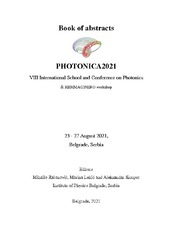Приказ основних података о документу
First glance at a multitude of ion currents on filamentous fungus P. blakesleeanus protoplasts obtained by femtosecond laser microsurgery
| dc.contributor | Rabasović, Mihailo D. | |
| dc.contributor | Lekić, Marina | |
| dc.contributor | Krmpot, Aleksandar J. | |
| dc.creator | Živić, Miroslav | |
| dc.creator | Stevanović, Katarina | |
| dc.creator | Pajić, Tanja | |
| dc.creator | Rabasović, Mihailo D. | |
| dc.creator | Krmpot, Aleksandar J. | |
| dc.creator | Todorović, Nataša | |
| dc.date.accessioned | 2022-01-17T13:51:36Z | |
| dc.date.available | 2022-01-17T13:51:36Z | |
| dc.date.issued | 2021 | |
| dc.identifier.isbn | 978-86-82441-53-3 | |
| dc.identifier.uri | http://radar.ibiss.bg.ac.rs/handle/123456789/4713 | |
| dc.description.abstract | Electrophysiology of cell membrane ion channels in filamentous fungi, unlike that in yeast, plant and animal cells is still in its infancy. The only two reports on single channel patch clamp recordings from native cell membrane of filamentous fungi were made on protoplasts obtained after cell wall microsurgery with UV pulsed laser more than 20 years ago. Both pioneering papers reported fairly high success rates of obtaining gigaohm contacts, but neither was followed by more studies. Advanced imaging techniques that enable more controllable surgery process and utilizing the femtosecond pulses, after optimizing the protocol, could result in minimally damaging cell wall microsurgery. The end result would be reproducibly high quality membrane of “de-walled” protoplasts. The membrane quality, property that is of utmost importance for application of patch clamp method, is a term describing not only mechanical integrity and cleanliness of the membrane, but the physiological fitness of the cell as well, as cells about to enter apoptosis or necrosis, or that were subjected to oxidative stress do not have it. We are presenting here, to the best of our knowledge, the first electrophysiological snapshot obtained on filamentous fungi protoplast after cell wall removal by a femtosecond laser microsurgery. Utilization of the Ti:Sa femtosecond laser with optimizations of the cell wall microsurgery protocol explained in this conference resulted in protoplasts that were prone to form contacts of high electrical resistance (GΩ) with a patch pipette. Ti:Sa laser operating at 730 nm (76 MHz, 160 fs pulse duration) combined with homemade nonlinear laser scanning microscope, physiological 40x 1.0 NA objective was employed for microsurgery and imaging. Standard patch-clamp set up was used for electrophysiology. In single channel recordings from more than 30 patches, 11 different channel types were distinguished, based on the reversal potential in asymmetric ionic conditions and on the conductance. By far, the most frequent types of conductance were anionic. We have found four groups of ion channel currents, based on ion selectivity: 1. Unselective anion currents (not discriminating between chloride and glutamate) 44% of all recorded currents. 2. Anionic currents selective for chloride (carried exclusively or mostly by chloride) 35%. 3. Organic acid permeable anionic currents (discriminating for glutamate over chloride) 17%; 4. Calcium cationic current was recorded once. The range of conductance size (g) was variable, with unselective anionic currents encompassing the smallest (5 pS) and largest (160 pS) recorded conductances. Calcium conductance was small (6 pS), while organic acid conductances and Cl-selective conductances had similar ranges (10-60 pS). Most of the conductances displayed linear current-voltage relationships. | sr |
| dc.language.iso | en | sr |
| dc.publisher | Belgrade : Institute of Physics | sr |
| dc.rights | openAccess | sr |
| dc.source | VIII International School and Conference on Photonics PHOTONICA2021 & HEMMAGINERO workshop | sr |
| dc.title | First glance at a multitude of ion currents on filamentous fungus P. blakesleeanus protoplasts obtained by femtosecond laser microsurgery | sr |
| dc.type | conferenceObject | sr |
| dc.rights.license | ARR | sr |
| dc.rights.holder | © 2021 by the Institute of Physics | sr |
| dc.description.other | Rabasović MD, Lekić M, Krmpot AJ, editors. Book of Abstracts: VIII International School and Conference on Photonics & HEMMAGINERO workshop: Photonica2021; 2021 Aug 23-27; Belgrade, Serbia. Belgrade: Institute of Physics; 2021. p. 111. | sr |
| dc.citation.spage | 111 | |
| dc.type.version | publishedVersion | sr |
| dc.identifier.cobiss | 44290057 | |
| dc.identifier.fulltext | https://radar.ibiss.bg.ac.rs/bitstream/id/9630/bitstream_9630.pdf | |
| dc.citation.rank | M34 | |
| dc.identifier.rcub | https://hdl.handle.net/21.15107/rcub_ibiss_4713 |

